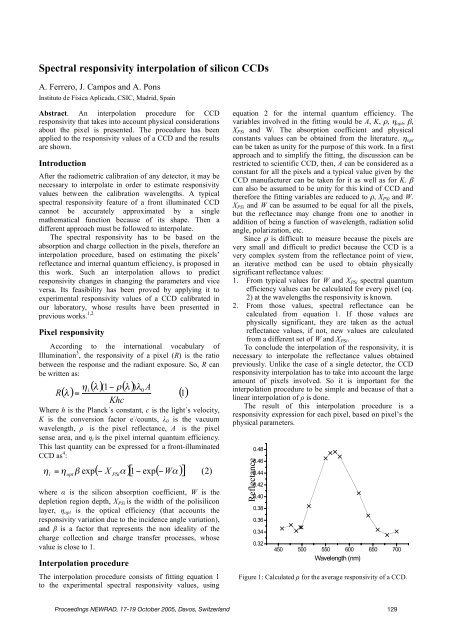Here - PMOD/WRC
Here - PMOD/WRC
Here - PMOD/WRC
Create successful ePaper yourself
Turn your PDF publications into a flip-book with our unique Google optimized e-Paper software.
Spectral responsivity interpolation of silicon CCDs<br />
A. Ferrero, J. Campos and A. Pons<br />
Instituto de Física Aplicada, CSIC, Madrid, Spain<br />
Abstract. An interpolation procedure for CCD<br />
responsivity that takes into account physical considerations<br />
about the pixel is presented. The procedure has been<br />
applied to the responsivity values of a CCD and the results<br />
are shown.<br />
Introduction<br />
After the radiometric calibration of any detector, it may be<br />
necessary to interpolate in order to estimate responsivity<br />
values between the calibration wavelengths. A typical<br />
spectral responsivity feature of a front illuminated CCD<br />
cannot be accurately approximated by a single<br />
mathematical function because of its shape. Then a<br />
different approach must be followed to interpolate.<br />
The spectral responsivity has to be based on the<br />
absorption and charge collection in the pixels, therefore an<br />
interpolation procedure, based on estimating the pixels’<br />
reflectance and internal quantum efficiency, is proposed in<br />
this work. Such an interpolation allows to predict<br />
responsivity changes in changing the parameters and vice<br />
versa. Its feasibility has been proved by applying it to<br />
experimental responsivity values of a CCD calibrated in<br />
our laboratory, whose results have been presented in<br />
previous works. 1,2<br />
Pixel responsivity <br />
According to the international vocabulary of<br />
Illumination 3 , the responsivity of a pixel (R) is the ratio<br />
between the response and the radiant exposure. So, R can<br />
be written as:<br />
R<br />
() <br />
i<br />
=<br />
() 1<br />
()<br />
)<br />
(<br />
0<br />
Khc<br />
Where h is the Planck´s constant, c is the light´s velocity,<br />
K is the conversion factor e - /counts, 0 is the vacuum<br />
wavelength, is the pixel reflectance, A is the pixel<br />
sense area, and i is the pixel internal quantum efficiency.<br />
This last quantity can be expressed for a front-illuminated<br />
CCD as 4 :<br />
= <br />
i<br />
opt<br />
exp<br />
where is the silicon absorption coefficient, W is the<br />
depletion region depth, X PSi is the width of the polisilicon<br />
layer, opt is the optical efficiency (that accounts the<br />
responsivity variation due to the incidence angle variation),<br />
and is a factor that represents the non ideality of the<br />
charge collection and charge transfer processes, whose<br />
value is close to 1.<br />
Interpolation procedure<br />
A<br />
() 1<br />
( ) [ 1<br />
exp( W)<br />
] (2)<br />
X PSi<br />
The interpolation procedure consists of fitting equation 1<br />
to the experimental spectral responsivity values, using<br />
equation 2 for the internal quantum efficiency. The<br />
variables involved in the fitting would be A, K, , opt , ,<br />
X PSi and W. The absorption coefficient and physical<br />
constants values can be obtained from the literature. opt<br />
can be taken as unity for the purpose of this work. In a first<br />
approach and to simplify the fitting, the discussion can be<br />
restricted to scientific CCD, then, A can be considered as a<br />
constant for all the pixels and a typical value given by the<br />
CCD manufacturer can be taken for it as well as for K. <br />
can also be assumed to be unity for this kind of CCD and<br />
therefore the fitting variables are reduced to , X PSi and W.<br />
X PSi and W can be assumed to be equal for all the pixels,<br />
but the reflectance may change from one to another in<br />
addition of being a function of wavelength, radiation solid<br />
angle, polarization, etc.<br />
Since is difficult to measure because the pixels are<br />
very small and difficult to predict because the CCD is a<br />
very complex system from the reflectance point of view,<br />
an iterative method can be used to obtain physically<br />
significant reflectance values:<br />
1. From typical values for W and X PSi spectral quantum<br />
efficiency values can be calculated for every pixel (eq.<br />
2) at the wavelengths the responsivity is known.<br />
2. From those values, spectral reflectance can be<br />
calculated from equation 1. If those values are<br />
physically significant, they are taken as the actual<br />
reflectance values, if not, new values are calculated<br />
from a different set of W and X PSi .<br />
To conclude the interpolation of the responsivity, it is<br />
necessary to interpolate the reflectance values obtained<br />
previously. Unlike the case of a single detector, the CCD<br />
responsivity interpolation has to take into account the large<br />
amount of pixels involved. So it is important for the<br />
interpolation procedure to be simple and because of that a<br />
linear interpolation of is done.<br />
The result of this interpolation procedure is a<br />
responsivity expression for each pixel, based on pixel’s the<br />
physical parameters.<br />
Reflectance<br />
0.48<br />
0.46<br />
0.44<br />
0.42<br />
0.40<br />
0.38<br />
0.36<br />
0.34<br />
0.32<br />
450 500 550 600 650 700<br />
Wavelength (nm)<br />
Figure 1: Calculated for the average responsivity of a CCD.<br />
Proceedings NEWRAD, 17-19 October 2005, Davos, Switzerland 129
















